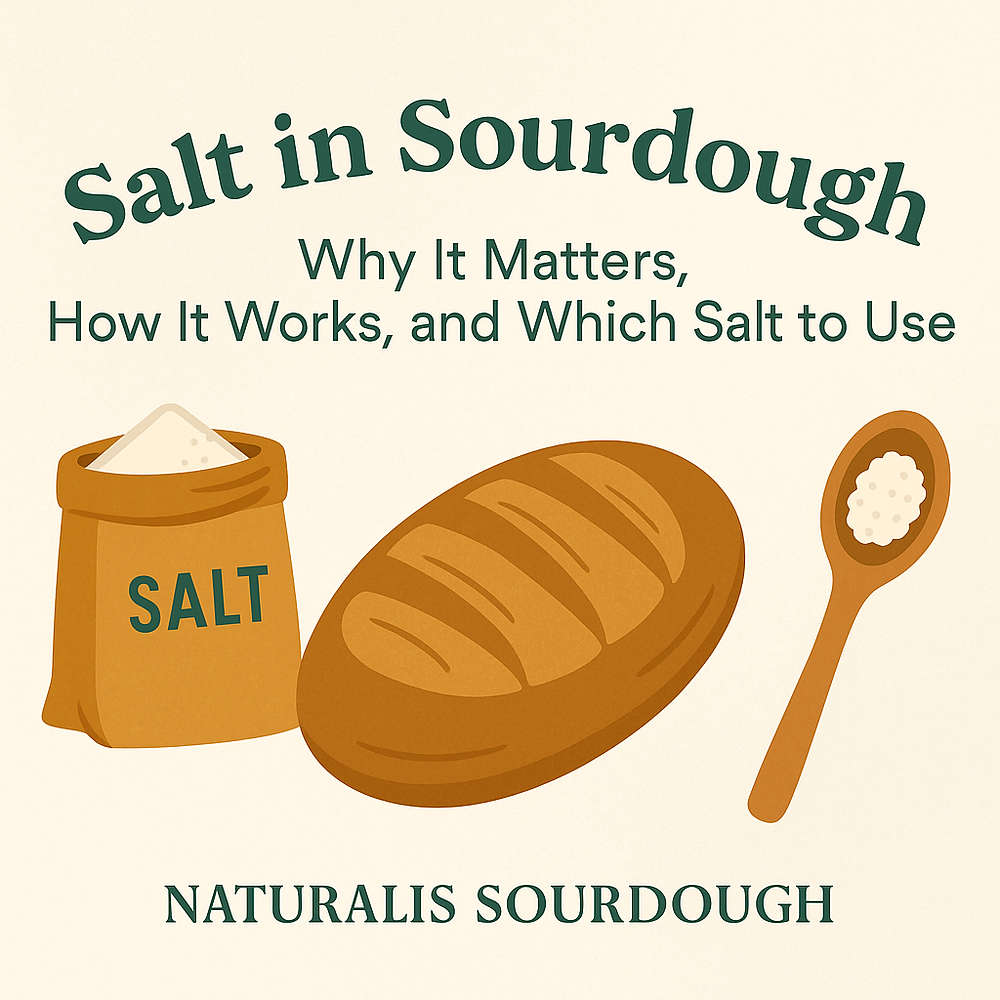

Salt in Sourdough: Why It Matters, How It Works, and Which Salt to Use
Jul 26
4 min read
0
10
0
When it comes to baking sourdough, flour, water, and wild yeast often get the spotlight. But quietly working behind the scenes is salt — the unsung hero that plays a critical role in fermentation, structure, flavor, and even shelf life.
In this deep-dive, you’ll learn:
What salt actually does in sourdough
How it affects gluten, fermentation, and flavor
Which types of salt are best (and which to avoid)
How to measure salt accurately every time
Common mistakes and pro tips
Let’s sprinkle in some knowledge.

🧪 What Does Salt Do in Sourdough?
Salt might only make up 1.5–2.5% of your dough, but its effects are powerful:
Strengthens Gluten
Salt tightens the gluten network, making dough more elastic and less sticky. This results in better oven spring and a chewier, structured crumb.
Science Tip: Salt stabilizes proteins by promoting ionic bonds, which reinforce gluten strands.
Slows Fermentation (In a Good Way)
Salt inhibits the activity of both yeast and lactic acid bacteria. This slows fermentation and gives you more control over your proofing schedule.
Without salt, dough ferments quickly and risks overproofing — especially in warm environments.
Enhances Flavor
Salt doesn’t just make bread taste “salty.” It enhances the natural flavors of the flour, rounds out sourness, and gives your bread depth.
Without salt, sourdough often tastes oddly sweet or metallic due to imbalanced acids.
Improves Crust and Shelf Life
Salt draws moisture to the surface during baking, which contributes to that beautiful crust. It also helps prevent spoilage by making the dough less hospitable to unwanted microbes.

📏 How Much Salt Should You Use?
The standard is:
Use 2% salt based on the total flour weight.
That means:
For 500g of flour → use 10g salt
For 1,000g of flour → use 20g salt
Always measure salt by weight. Volume is unreliable because crystal size varies.
🔬 When to Add Salt (and Why It Matters)
During Autolyse (Before Salt)
Many bakers prefer to autolyse without salt for 20–60 minutes. This allows flour and water to hydrate and gluten to begin forming without salt tightening the structure too early.
After Autolyse: The “Bassinage” Method
Dissolve salt in a small portion of your water and add it after autolyse. This allows for better gluten development and easier mixing.
Pro Tip: If adding salt late, mix gently at first. Salt stiffens the dough and can cause tearing if not carefully incorporated.

🧂 Salt Comparison Chart for Sourdough Baking
Here’s a simple breakdown of popular salts for sourdough, written in plain text for easy reference:
1. Fine Sea Salt
Crystal Size: Small
Additives: No
Best Use: Everyday sourdough baking
Notes: Dissolves quickly; has a clean, natural flavor. Easy to weigh and use consistently.
2. Kosher Salt
Crystal Size: Large flakes
Additives: Usually none (check label)
Best Use: Use only if measuring by weight
Notes: Different brands vary in flake size (e.g., Diamond Crystal is lighter than Morton).
3. Himalayan Pink Salt
Crystal Size: Medium (varies)
Additives: No
Best Use: Adds minerals and subtle flavor
Notes: Must be finely ground for dough; large crystals won’t dissolve well.
4. Table Salt
Crystal Size: Very fine
Additives: Yes (anti-caking agents, iodine)
Best Use: Not recommended for artisan sourdough
Notes: Can cause off flavors or affect fermentation.
5. Flaky Salt (e.g. Maldon)
Crystal Size: Very large
Additives: No
Best Use: Finishing salt only — sprinkle on top after baking
Notes: Great for topping, not for mixing into dough.

⚖️ Why You Should Weigh Salt (Not Measure by Teaspoons)
Because salt types vary so much in density, a teaspoon of one kind can weigh twice as much as another.
Examples:
1 tsp fine sea salt ≈ 5g
1 tsp Morton kosher ≈ 6g
1 tsp Diamond Crystal ≈ 3g
Weigh it out. Always.
Naturalis Tip: At Naturalis Sourdough, we use fine Mediterranean sea salt in every loaf — clean, additive-free, and easy to measure.
❌ What Happens If You Forget Salt?
Oops — it happens to every baker eventually. Here’s what to expect:
Dough will ferment too fast
Dough may feel overly wet or slack
Final bread may overproof and collapse
Flavor will be flat or unpleasantly sour
Crumb may be gummy and crust too soft
Don’t toss it! Use unsalted loaves for croutons, stuffing cubes, or sourdough crackers.
🧠 Common Salt Questions
Can I use flavored or smoked salt?
Only as a finishing salt. In dough, it can interfere with fermentation or overpower flavor.
Can salt kill my sourdough starter?
Not in normal amounts. Just don’t pour it directly onto the starter. Always mix evenly into dough.
Can I reduce salt for health reasons?
Yes — but too little salt can lead to wet, hard-to-handle dough and a bland loaf. Try starting with 1.75% and adjust gradually.

🍞 Final Thoughts
Salt is your sourdough sidekick. It doesn’t just season — it shapes the entire process. Understanding how it works and choosing the right type will help you bake better, more flavorful bread every time.
At Naturalis Sourdough, we bake every loaf with intentional ingredients — including hand-harvested sea salt — and slow fermentation to bring out the best in every bite.
Want more helpful tips like this?
🛒 Shop our dehydrated starter kits or sourdough guidebook at www.NaturalisHerbal.com
📍 Visit us at local Alabama farmers markets
📬 Subscribe to the newsletter for new blogs, freebies, and seasonal sourdough tips





